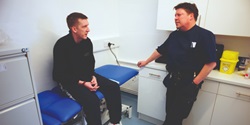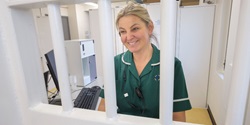Student one
“I worked with a wide range of staff throughout my placement including nurses, pharmacy technicians, healthcare support workers and mental health staff. This meant I participated in a wide range of interventions including but not limited to; wound care, dispensing of medication, mental health assessments, attending to emergency calls, and welfare checks. Many of these types of care included very close patient contact, often in their cells or on a wing of the prison. From this, I was able to build relationships with many of the prisoners and learn about their life experiences…. In the case of attending emergency calls, sometimes the prison could be a distressing environment. After intense emergency calls, staff re-convened and discussed each of their roles in the call and emotionally supported one another throughout. Staff’s care for not only patients, but each other was at the core of all of their interactions which resulted in a strong and supportive team that left nobody behind. Despite this, the environment always remained cheery, and staff were never afraid to make each other laugh” (student reflection, 2022).
Student two
"To kickstart my final year as a student nurse, I elected to have a placement in Wandsworth prison – a decision I quickly doubted. As somebody who gets tense phoning the bank, I couldn’t help but become quite nervous when it actually sunk in that I’d be working in one of Britain’s largest men’s prisons. As a young woman with, admittedly, little backbone, I felt overwhelmed when seeing documentaries and the news surrounding work in prisons. On the whole, it looked violent, unforgiving, scary, and filled with ‘society’s villains’. I approached it with the attitude that it simply wouldn’t be the same, nurturing relationship I would encounter caring for a sweet elderly lady on a general medical ward in a little community hospital.
My apprehension was reinforced as I first approached the prison gates, hearing alarms blaring just beyond them and remembering everything negative that I had ever heard about prison life. But once escorted through, I was met with one of the warmest welcomes I’d received in a clinical placement. A sea of smiles greeted me and my fellow student nurse; we both immediately felt part of the team. My first clinical shift was out on the wings with the emergency response nurse, which introduced me to prison nursing face first, in at the deep end, with arguably no diving gear, no goggles and no idea what to do next. However, within the first minute of treating my first patient, I realised that the prisoners were certainly not ‘society’s villains’ as I’d previously been led to believe; they were in fact some of the most vulnerable patients I had ever cared for. With that came a stronger sense of community than I expected, with prisoners looking after prisoners, and a sense of respect between the prisoners, officers and healthcare team. I also quickly realised that, often without people fighting in their corner, prisoners are faced with massive barriers in their access to healthcare, and both the officers and the healthcare team at Wandsworth prison worked tirelessly to uphold their rights.
The wings of the prison are often loud and chaotic, but I’ve not worked in many hospital wards that aren’t like that. I won’t pretend that I wasn’t presented with conflict, stress, and challenges that I’d never encountered before, but it meant that I learnt an incredible amount. Managing opioid and psychoactive substance overdoses, musculoskeletal trauma, hypovolaemia, unstable angina, substance misuse, alcohol detoxing, self-harm, suicide attempts, psychosis, seizures, and severe concussions and using independent clinical assessments and decision-making skills meant that these became some of my greatest strengths. I worked predominantly with the emergency response nurse, meaning we would be presented with myriad health problems, ranging from a measly paper cut to a gentleman with aGCS-3 and respiratory depression. The nature of the environment meant that independent clinical judgement and rapid, accurate assessments were integral. This fostered a fantastic teaching environment, as my practice supervisors would often let me take the lead but continued to support me when I was blaringly clueless, helping me develop immensely.
The nursing team were some of the most autonomous, intelligent, proactive and highly skilled nurses I’ve ever had the pleasure of working with. Many times, solutions could only be met by thinking outside of the box, giving room for the nurses to deliver truly compassionate, person-centred care. In such an overlooked area of care delivery, I feel these unsung heroes deserve more acclaim for the work they do. The stigma and fear surrounding prison healthcare doesn’t do the reality justice, and I would encourage my peers to consider gaining experience in this area. The privilege of working inside Wandsworth prison, learning from incredible clinicians, and caring for an incredibly complex patient group has taught me so much, and since starting there, not once did I regret my decision. I may still be afraid of phoning the bank, but I’m most certainly not afraid of stepping inside prison (Student reflection, 2021).














